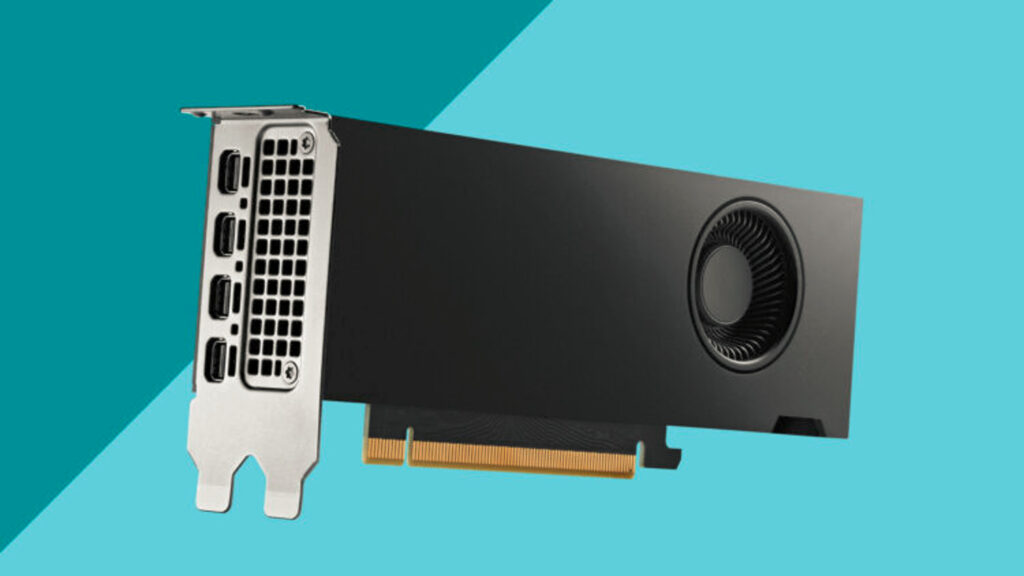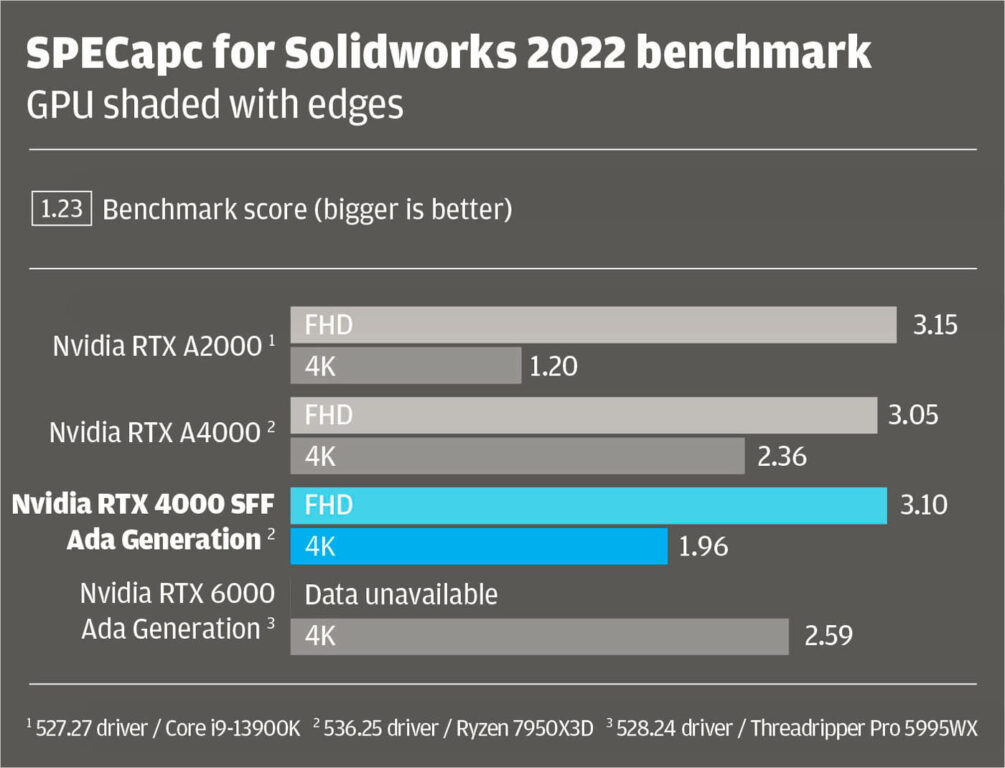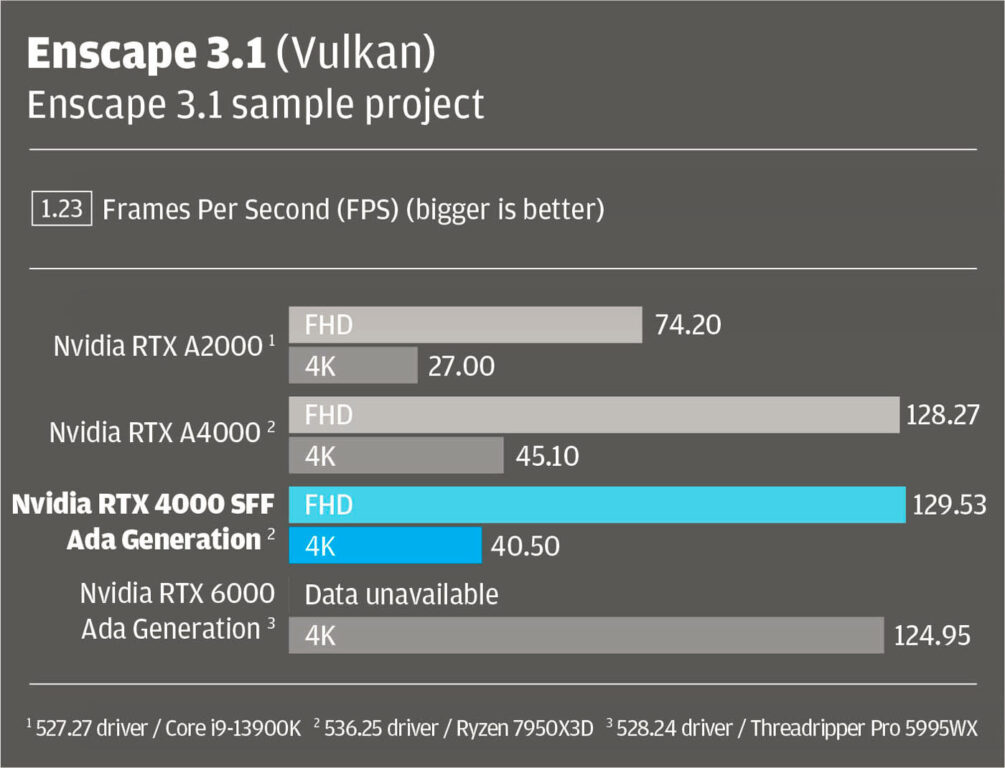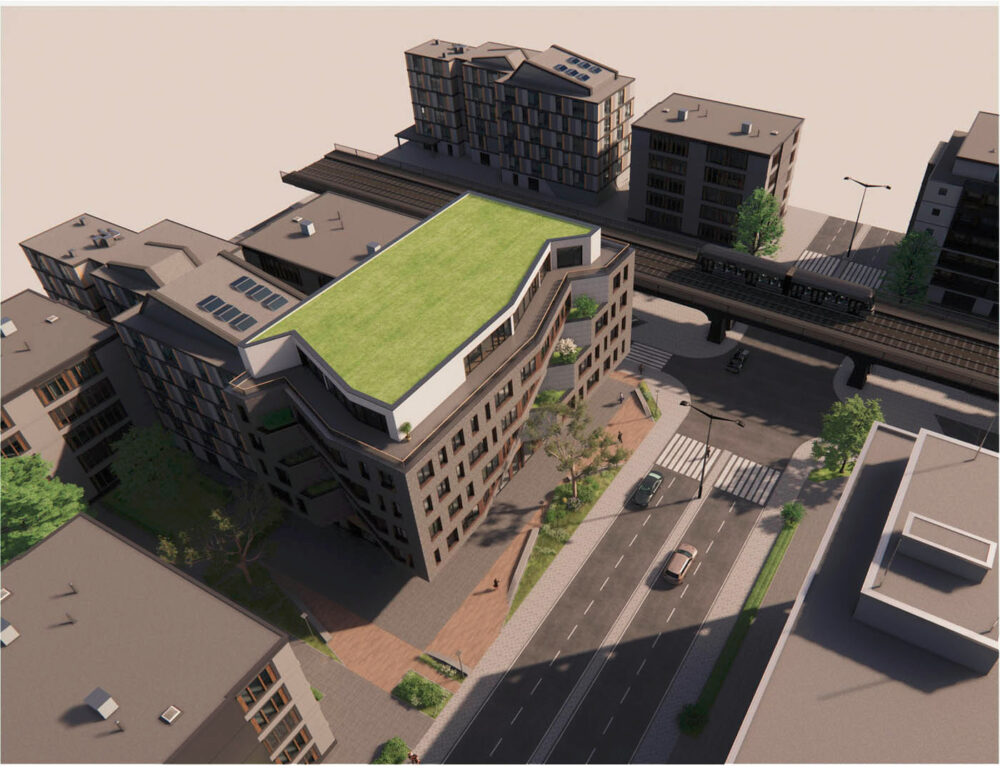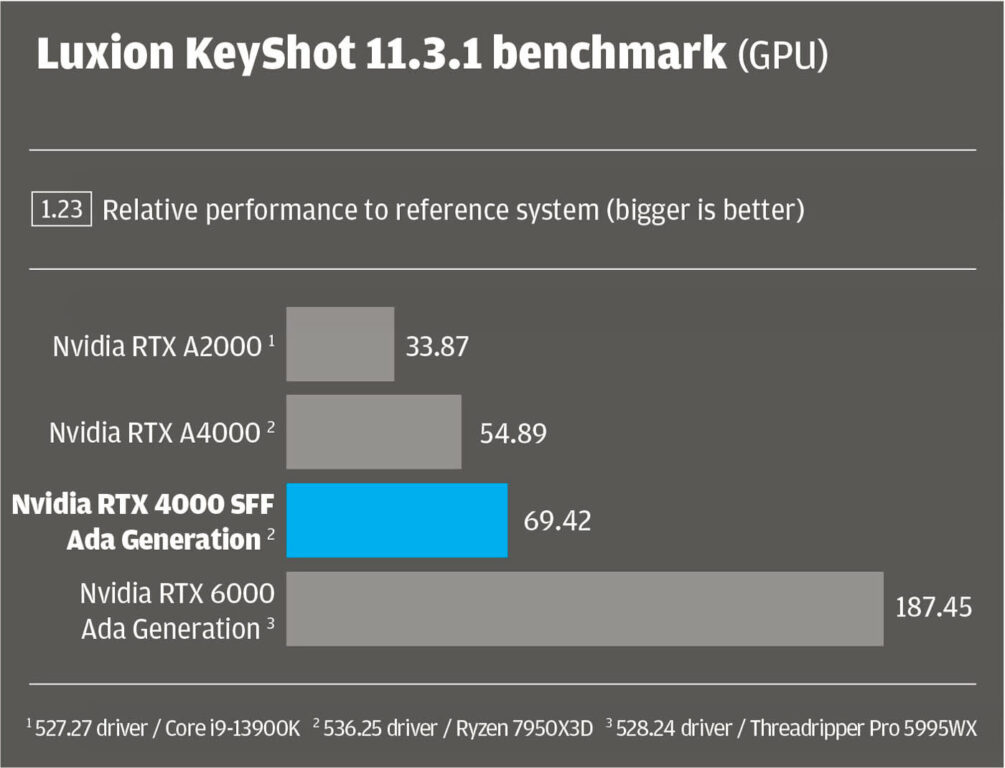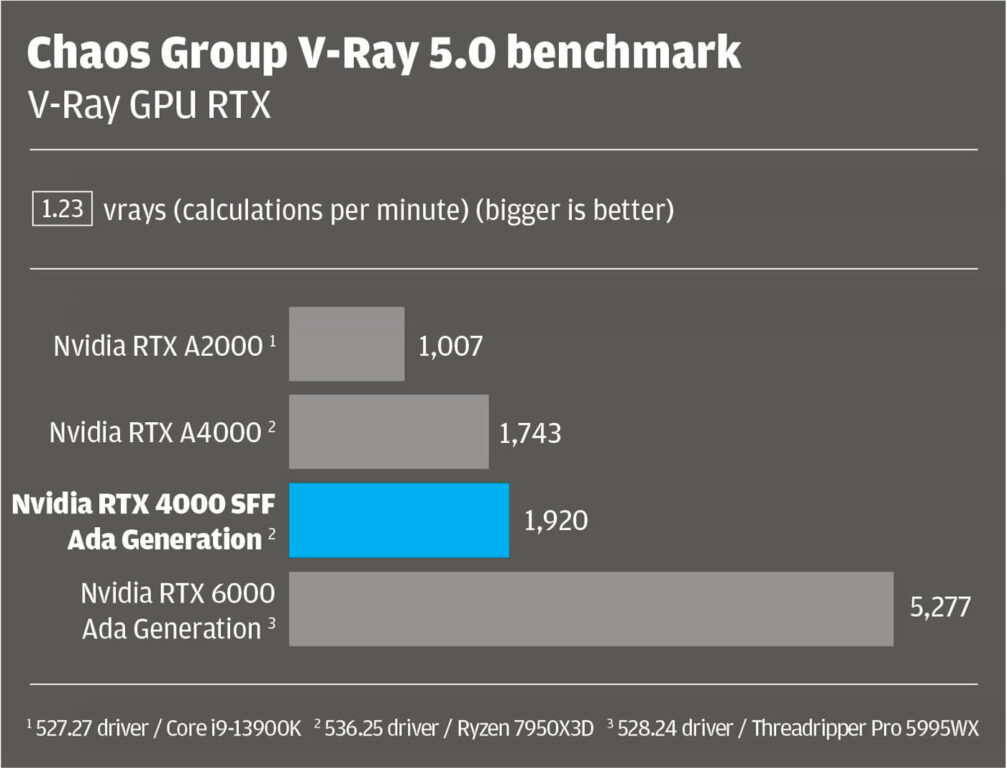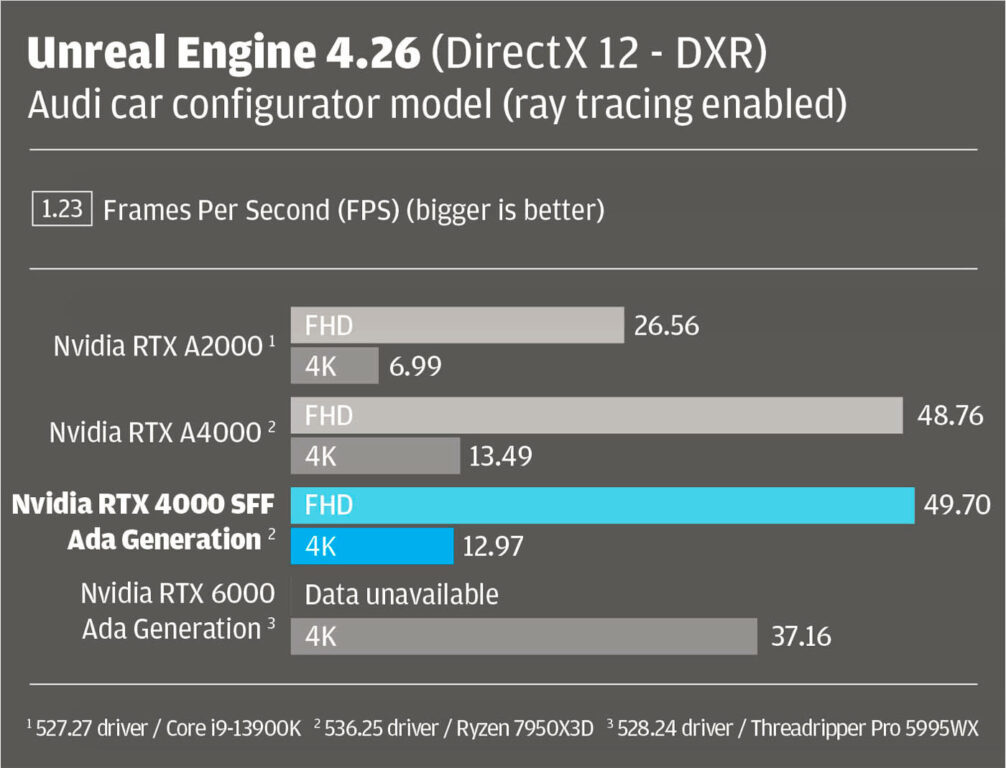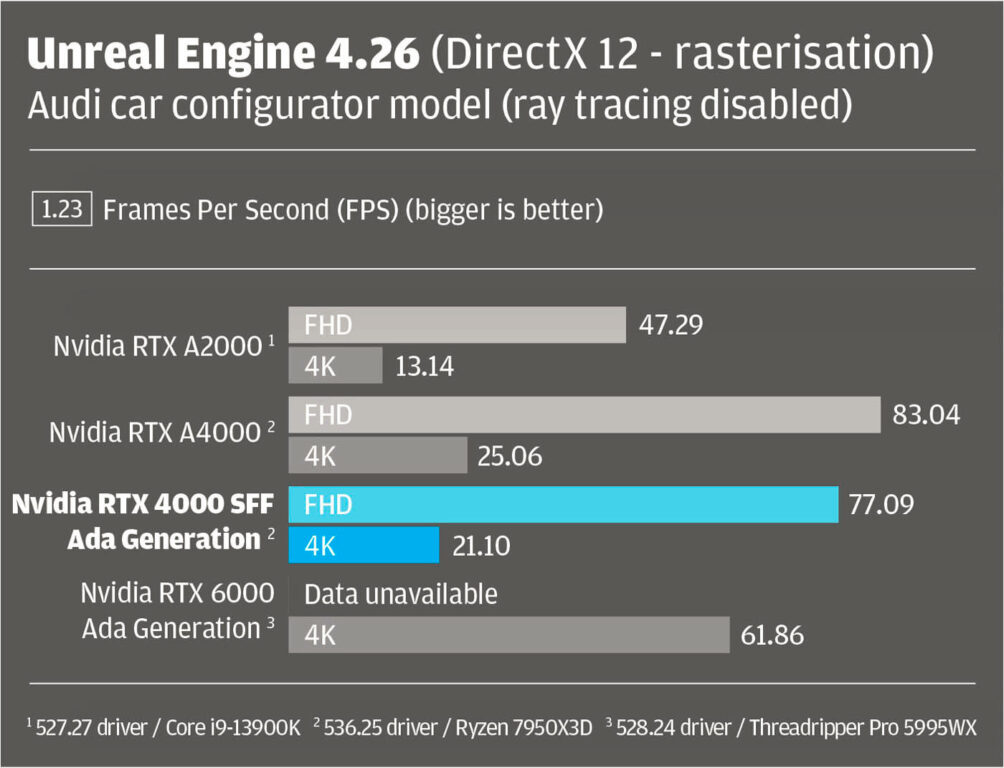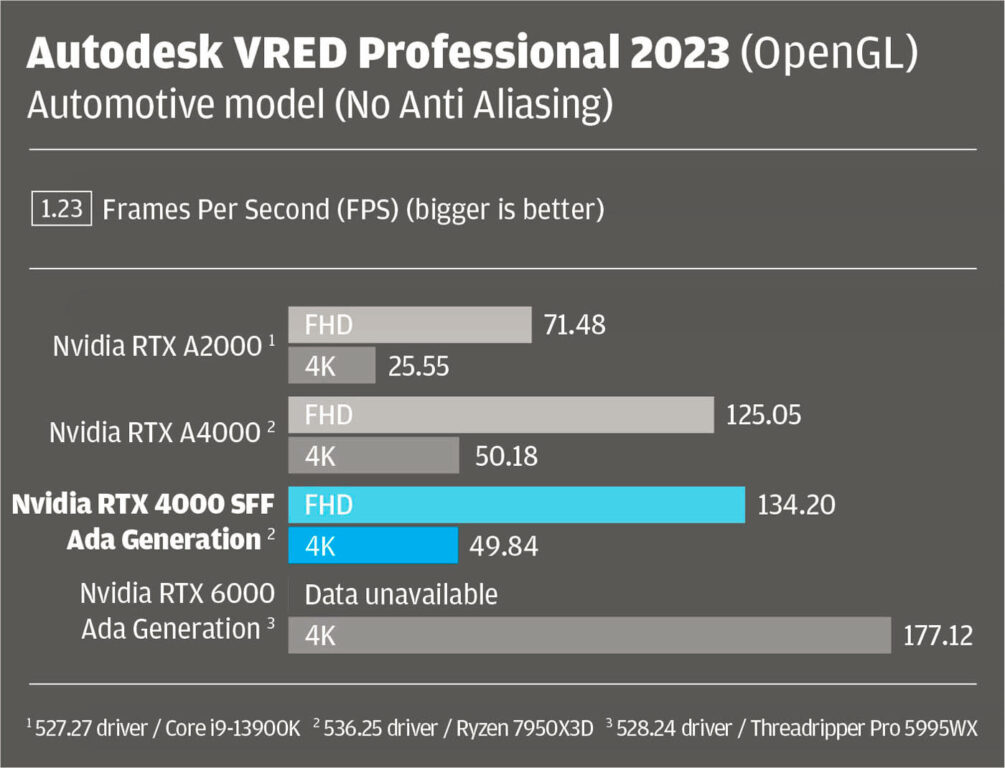The compact Nvidia RTX 4000 SFF Ada Generation workstation GPU delivers in all types of design and engineering workflows, but you’ll pay a premium for this level of performance in such a small package, writes Greg Corke
Price: £1,249 + VAT
Low profile workstation GPUs — those with a half-height bracket and moderate power demands — are big business these days.
You’ll find them in more types of desktop workstation chassis than ever — not just SFFs / Small Form Factors (think, two 12-inch pizza boxes stacked) but ultra-compacts as well (the 7-inch personal margarita equivalent).
These compact machines don’t just bring order to space-constrained offices; they play an increasingly important role in centralised workstation solutions, offering impressive density in racks.
It is no surprise that they are among the biggest selling workstations from Dell, HP, and Lenovo.
Small size, big power
For years, low profile graphics cards only really had enough power for entry-level 2D/3D tools including CAD. However, some GPU models have now caught up with more demanding 3D workflows, and offer a more rounded solution for professionals.
Revit, Archicad, Vectorworks and SketchUp are a given, but some low-profile cards can now put in a good shift with companion viz tools like Enscape, Twinmotion, Lumion, Chaos Vantage, Chaos V-Ray and Nvidia Omniverse.
The new contender
The Nvidia RTX 4000 SFF Ada Generation (20 GB) is only the second workstation GPU to be based on Nvidia’s Ada Lovelace architecture. It follows the phenomenally powerful, but phenomenally expensive (£6,750 + VAT), Nvidia RTX 6000 Ada Generation (48 GB), which we reviewed in our recent summer 2023 Workstation Special Report.
The Nvidia RTX 4000 SFF Ada picks up where the Ampere-based Nvidia RTX A2000 left off. It has the same dual slot, low profile form factor, radial fan, four mini DisplayPort 1.4a connectors and 70W max board power, so it doesn’t need an external 6-pin connector. It comes with both a half-height and full-height ATX bracket, so it can be used in full sized towers as well.
Nvidia’s new Ada Lovelace architecture gives it a significant boost in performance over the Nvidia RTX A2000, which we will explore in more detail later. It also has significantly more memory (20 GB vs 12 GB), which makes it capable of handling some rather substantial viz datasets, now and well into the future.
In some ways the Nvidia RTX 4000 SFF Ada Generation marks a true coming of age for the compact workstation
If the Nvidia RTX 4000 SFF Ada Generation is the natural successor to the Nvidia RTX A2000 why not call it the Nvidia RTX 2000 SFF Ada Generation?
A cynic might suggest it’s to elevate the GPU’s standing so Nvidia can charge more money. At £1,249 + VAT, the Nvidia RTX 4000 SFF Ada certainly isn’t cheap and costs considerably more than the Nvidia RTX A2000 (12 GB) — currently available for £470 (Ex VAT), although this price is a little cheaper than it has been over the last 12 months.
Alternatively, it could be that Nvidia intends to use the exact same silicon, but clocked higher, in the as-yet released full height, single slot 140W Nvidia RTX 4000 Ada GPU. Or, simply to differentiate it more from the Nvidia RTX A2000, which will continue to sit in Nvidia’s low-profile product stack, alongside the CAD-focused Nvidia T1000 and T400.
Whatever the reason, the Nvidia RTX 4000 SFF Ada will bring a substantial price increase to SFFs and ultra-compact s, which have traditionally been entry-level workstations. So, what exactly do you get for your money?
Nvidia RTX 4000 SFF Ada on test
For testing, we compared the Nvidia RTX 4000 SFF Ada generation (20 GB) with the Nvidia RTX 6000 Ada (48 GB) and two Ampere generation GPUs — the low-profile, dual slot Nvidia RTX A2000 (12 GB) (read our review) and full height, single slot Nvidia RTX A4000 (16 GB) (read our review).
Here, it’s important to state that our benchmark comparisons aren’t perfect, as not all GPUs were tested in the same machine. For the Nvidia RTX 4000 SFF Ada generation and Nvidia RTX A4000 we used the latest 536.25 driver inside an AMD Ryzen 7950X3D-based workstation from Armari. For the other two GPUs data was taken from previous articles. The Nvidia RTX A2000 with 527.27 driver was tested inside an overclocked Intel Core i9-13900K-based BOXX Apexx S4 workstation. The Nvidia RTX 6000 Ada with 528.24 driver was tested inside an AMD Threadripper Pro 5995WX-based workstation.
We would expect Nvidia RTX A2000 benchmark scores to be elevated a little in 3D CAD, as the Intel Core i9-13900K is faster than the AMD Ryzen 7950X3D in single threaded and lightly threaded workflows and CAD is typically very CPU limited with 3D graphics. However, in graphics intensive real-time viz tools processors shouldn’t make much difference and, in GPU rendering, virtually none at all.
Now we’ve got the disclaimers out of the way, let’s dive into the results.
For CAD, the RTX 4000 Ada more than delivered. In the SPECapc for Solidworks 2022 benchmark, it maintained high performance at all resolutions, while the Nvidia RTX A2000 dropped off a little at 4K. Of course, benchmark figures only tell one part of the story, and the Nvidia RTX A2000 should still give you everything you need and more in most 3D CAD workflows.
The RTX 4000 SFF Ada brings real benefits to real-time viz. Whereas the RTX A2000 falters a little in some 4K workflows, the RTX 4000 SFF Ada just keeps going. It’s only when anti-aliasing is set to ultra-high in VRED Professional 2023, or real time ray tracing is enabled in Unreal Engine 4.26, that it starts to struggle, staying well below the desirable 20+ Frames Per Second (FPS).
For ray trace rendering, it’s a significant step up from the RTX A2000. Compared to the RTX A4000, it was 1.26 times faster in KeyShot, 1.1 times faster in V-Ray, but was a touch slower in Solidworks Visualize 2022.
In summary, you can expect around twice the performance of an Nvidia RTX A2000 and similar performance to a full height, single slot Nvidia RTX A4000, although the RTX 4000 SFF Ada uses half the power (70W vs 140W).
The verdict
Typically, when Nvidia launches a new GPU architecture it starts at the high-end with a 6000 Series model, then works its way down the stack, adding a dual slot 5000 and single-slot 4000. With Ada Lovelace, it has taken a different approach and prioritised the low-profile form factor, so it has a premium offering in both full-size tower and compact workstation market segments. And considering how well small workstations continue to sell, this is hardly surprising.
The Nvidia RTX 4000 SFF Ada Generation is a very impressive GPU. It packs an incredible amount of processing power into a small 70W package, delivering excellent performance for many different workflows, even at 4K resolution where it overcomes some of the limitations of the Nvidia RTX A2000. In some ways it marks a true coming of age for the compact workstation.
But, at £1,249 it certainly isn’t cheap. It represents a big step up in price from the Nvidia RTX A2000 and will significantly increase the cost of a top-end compact workstation. It feels like Nvidia is placing a premium on the space saving design.
To provide some context, and putting form factors to one side, the RTX 4000 SFF Ada offers similar performance to the older RTX A4000, which currently sells for under £900. Indeed, for those who use full-size towers, the RTX A4000 looks better value for money in many workflows – something you wouldn’t expect from an older technology. However, you do get slightly less memory and the RTX A4000 doesn’t support the latest Nvidia technologies including Deep Learning Super Sampling 3 (DLSS) and Shader Execution Reordering (SER).
Of course, it’s still early days for the Nvidia RTX 4000 SFF Ada and the Ada Lovelace architecture in general, and prices may well come down.
It will be interesting to see the specs and cost of the forthcoming full height, single slot 140W Nvidia RTX 4000 Ada. It should tell us more about how Nvidia is addressing the burgeoning compact desktop workstation market.
The Nvidia Ada Lovelace architecture
The Nvidia Ada Lovelace GPU architecture, named after the English Mathematician credited with being the first computer programmer, launched last year.
The Nvidia RTX 6000 Ada Generation was the first workstation GPU, which has how been joined by the Nvidia RTX 4000 SFF Ada Generation.
All Ada generation GPUs can call on three different types of processing cores, as and when required, and depending on software compatibility.
There are CUDA cores for general purpose graphics, RT Cores for ray tracing, and Tensor Cores for AI operations.
Tensor cores can be applied in many different ways. In viz they are primarily used to decrease render times or boost real-time performance. This can done through ‘denoising’, the removal of grainy spots and discoloration from renders, ‘upscaling’, a process that turns lower resolution frames into higher resolution frames (DLSS 2), or for creating brand-new frames without having to process the graphics pipeline (DLSS 3).
DLSS 3 is unique to the Ada Lovelace architecture and so far we’ve only seen it implemented in Nvidia Omniverse, but we expect others to follow. Enscape and Autodesk VRED, for example, both support DLSS 2.

